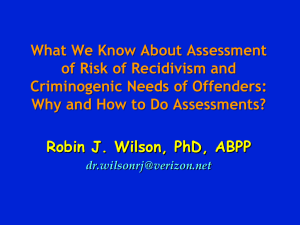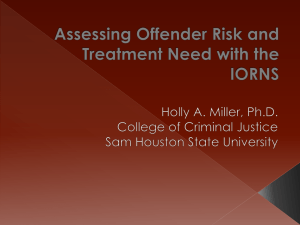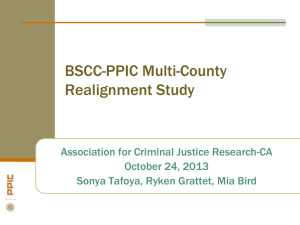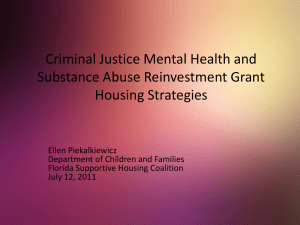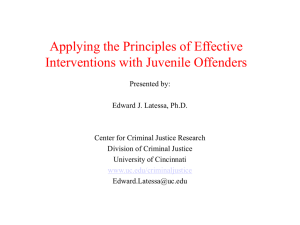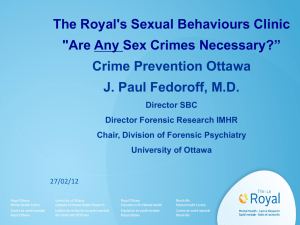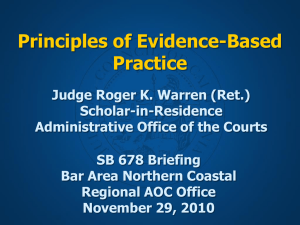Road to Recovery - Politics and Government| Illinois State
advertisement
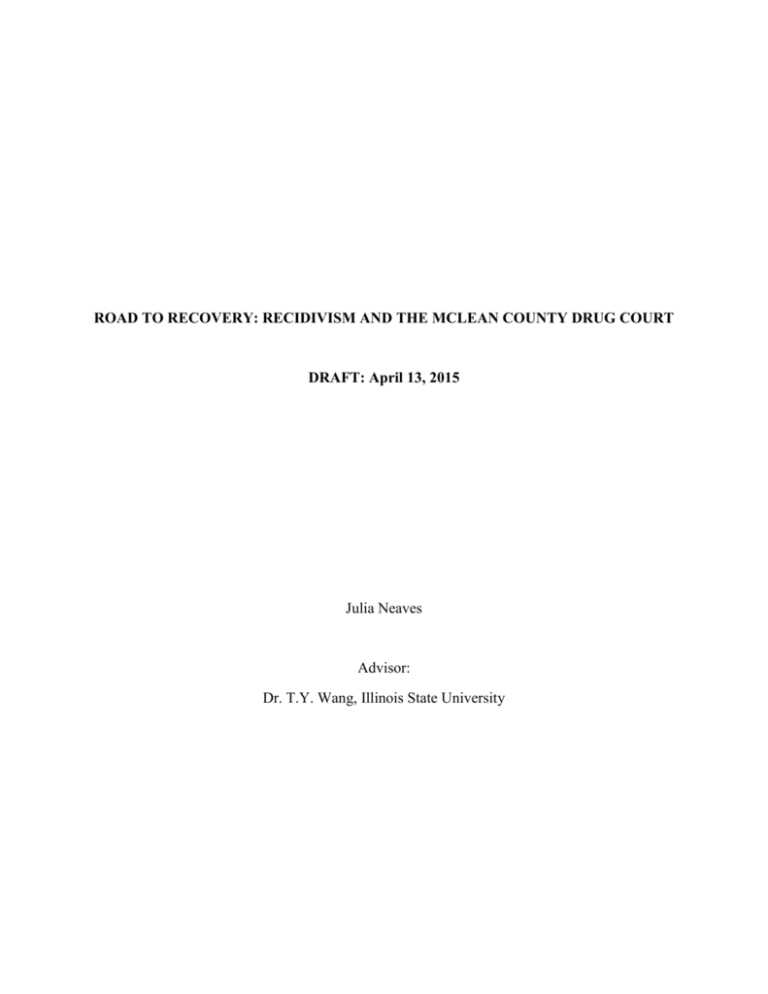
ROAD TO RECOVERY: RECIDIVISM AND THE MCLEAN COUNTY DRUG COURT DRAFT: April 13, 2015 Julia Neaves Advisor: Dr. T.Y. Wang, Illinois State University 2 Table of Contents Introduction ……………………………………………………………………………………………...…3 Literature Review ……………………………………………………………………………………..……5 i. ii. iii. Rehabilitation, Deterrence and the Drug Court …..………………..……………………..5 Issues in Methodology ……………………...………..………………………..……..….. 7 Findings …...……..………………..………………………………………………...……8 McLean County Drug Court …………………………………………………………………………...…11 Methods ………………………………………………………………………………………………...…12 i. ii. iii. iv. Research Questions ……….…...………..……………………………………..…….…..12 Crime Theory and Control Variables………………………………………………….…12 Data Sources……….…...………..……………………………………..………………..16 Research Design…………………………………………………………………………16 Data Summary and Analysis.………………….…………….…...……..…………………………………19 Limitations and Future Recommendations……………………..…………………….………………...…23 Conclusion………………………………….……………………………………………………………..25 Bibliography ………………………………………………………………………….….………………..26 3 Introduction Philosophies informing the role of the criminal justice system have developed and changed throughout American history. While originally viewed as predominantly penal in nature, the modern justice system frequently utilizes reintegration and rehabilitation programs such as probation and job training in lieu of or in conjunction with traditional incarceration policies. Criminal justice officials hope that such programs will reduce the number of reoffenders, thereby reducing the strain on America’s overburdened criminal justice system. One of the more popular emerging practices is the adoption of problem-solving courts, courts that seek to address issues that contribute to high probability of re-offense such as drug use and mental illness. The first U.S. problem-solving courts opened in the early 1990’s and there are several thousand courts in operation today (Bureau of Justice Assistance 2014). In 2008, the McLean County, IL Court system experienced unprecedented rates of incarceration. The resultant overcrowding stressed the county’s financial resources and placed additional burdens on court and jail staff. In response to significant criticisms in the wake of 2008, the county formulated a Criminal Justice Coordinating Council (CJCC) comprised of several key criminal justice agencies and partners. The CJCC aims to research and implement evidenced-based best practices that “provide fair and just outcomes, improve public safety, reduce recidivism, and responsibly use resources for the benefit of McLean County residents.” There are nineteen permanent members of the CJCC board including the Chief Circuit Judge, County Sheriff and State’s Attorney (McLean County Criminal Justice Coordinating Council). Since 2008, the CJCC and its county collaborators have rapidly expanded the availability of pre and post-trial services, including specialty courts. The effects of court-based programs have been studied nationally; however, few efforts have been made to assess outcomes at the 4 local level. The CJCC’s ongoing partnership with Illinois State University’s Stevenson Center for Community and Economic Development aims to gather and analyze data towards this and other evaluative purposes. The focus of this study is to evaluate the effectiveness of the McLean County Drug Court, which began operating in 2006. The study employs survival analysis techniques to determine if drug court treatment significantly reduces time to recidivism. Several sociodemographic and criminal history-related explanatory variables are also tested for significance. The study aims to provide useful information to drug court administrators that may inform future decisions regarding drug court treatment and expansion efforts. Additionally, this research adds to recidivism literature as a whole by informing future models that seek to evaluate drug courts and recidivism in a local context. 5 Literature Review There is a growing body of literature assessing the effectiveness of drug courts in reducing participant re-offense rates. Studies have been conducted within individual court systems as well as on the aggregate level, with mixed and widely variable outcomes. This literature review presents a historic view on drug-based correctional treatment as it relates to the development of the alternative court system. The review also outlines methodologies and findings in drug court research in an effort to inform the McLean County study. Rehabilitation, Deterrence and the Drug Court Prior to 1970, rehabilitation was the preferred approach for persons with drug violations (Andrews, Zinger, Hoge, Bonta, Gendreau & Cullen, 1990; Cullen & Gendreau 2000). Rehabilitation programs aimed to target issue areas related to criminality such as addiction, mental health, educational attainment, and cognitive processing. Rehabilitation’s overarching aim was to reduce recidivism rates (Cullen & Gendreau, 2000). Scientific research conducted in the 1970’s, however, dealt a significant blow to the rehabilitation approach. A meta-analysis of over 300 U.S. rehab programs conducted by Lipton, Martinson and Wilkes revealed “no appreciable effect” of rehabilitation programs on recidivism (Lipton, Martinson & Wilkes, 1975 as cited in Andrews et al., 1990; Martinson 1974). This ushered in the era of the “Nothing Works” doctrine, which harshly criticized rehabilitation programs and re-ignited a focus on incarceration-centric policies (Cullen & Gendreau, 2000, p. 119). The renewed focus on incarceration policies through the late 1900’s has led to system overcrowding. From 1970 to 1990, the number of prisoners in state or federal prison in the United States tripled, from 100 to 300 per 100,000 residents (Raphael & Stoll, 2008, p. 73). While this increase can be attributed to a number of different factors, increased drug admissions 6 assuredly played a role (Listwan, Sundt, Holsinger, & Latessa, 2003, p. 390). According to data from Raphael and Stoll (2008), U.S. prison admissions for drug related offenses rose from approximately 10 percent to approximately 32 percent of all admissions in the latter 1980’s alone (p. 79). The increasing number of arrests during this time period overloaded the court system, lengthening case processing time and overcrowding jails and prisons across the country. The response to this was a renewed interest in community-based treatment programs that could lessen the burden on systems of incarceration (Listwan et al., 2003; Zehr & Toews, 2004; Fulkerson 2012). Drug courts were one of several community-based alternatives enacted in the late 1980’s and early 1990’s. The primary operating goals of a drug court are to reduce drug use, address external and internal issues that pre-dispose individuals to commit crime and ultimately to reduce recidivism (Belenko, 2001; Brown, 2011). Drug courts operate with an interdisciplinary team of court and treatment specialists including a judge, lawyers, mental health providers and probation officers, among others. Participants agree to a set of rules which typically include substance abstinence, random drug testing, restitution payments and attendance at all mandated hearings and treatment sessions. In exchange, incarceration time is reduced or, in some cases, eliminated entirely (Huddleston, Marlow & Casebolt, 2008, p. 7). Drug courts have become popular alternatives in the American court system; there were approximately 700 drug courts operating in 2000 and that number has grown to over 2600 courts in 2014 (Belenko, 2001, p. 5; Gallagher, 2014; Brown, 2011). Federal funding for drug courts increased 250 percent from 2008 to 2010 alone and an estimated 70,000 persons are enrolled in U.S. drug court programming at any given time (Huddleston, et all, 2008, p. 2). 7 Issues in Methodology Research on the effectiveness of drug courts in reducing recidivism has grown with the expansion of drug court programming. While most studies have been conducted on the individual district level, several meta-analyses have been completed, most notably Belenko (2001), Lowenkamp, Holsinger & Latessa (2005), Wilson, Mitchell & MacKenzie (2006) and Shaffer (2011). Each of these meta-analyses characterized the field of drug court recidivism research as having weak methodology stemming from a lack in both definitional standards and statistical rigor. The former issue derives from the absence of a standard practice definition of recidivism. The following table presents a sample of definitions used in selected alternative court recidivism studies. Study National Institute of Justice (2014) McClure (2013) Brown (2011) Roman, Townsend & Bhati (2003) Banks & Gottfredson (2003) Definition of Recidivism A re-arrest, reconviction or return to prison with or without a new sentence during the 3year period following prison release Any charge within 2 years of program completion Any reconviction Any arrest and charge for an offense punishable by incarceration for at least one year following a previous offense Any arrest within 2 years of program completion McLean County Court Administrator W. Scanlon claims that different definitions of recidivism are more or less important to different criminal justice system players. Judges, for example, may be concerned with measuring recidivism as it relates to reconviction, whereas jail supervisors may consider re-arrest to be more significant (personal communication, October 3, 2014). In any case, the lack of a clear, consistent definition of recidivism restricts comparison of studies at the aggregate level (McCoy, 2010, p. 65). 8 Lack of attention to sample size, participant bias and graduation status has also hindered alternative court evaluation. Several researchers note that studies utilizing small sample sizes and short follow-up timeframes to measure recidivism are common, but theoretically unreliable (Belenko, 2001; Mitchell, Wilson, Eggers & MacKenzie, 2012; Brown, 2011). Numerous studies also fail to differentiate between court participants who self-select into the program and those whose participation is court mandated (Brown, 2011; McClure 2013; McCoy 2010). Wilson et al. (2012) estimated that, of the hundreds of drug court studies they surveyed, about half “did not use random assignment, statistical control, or subject level matching” (p. 468.) Additionally, Belenko (2001) and Gallagher (2014) note that the majority of studies focus exclusively on drug court program graduates as opposed to all program participants. With drug court dropout rates exceeding 50 percent on average, Belenko (2001) contends that excluding program drop-outs may bias rates of participant success (p. 54). Findings Given the wide range of methodological issues, assessing findings within the aggregate literature is difficult. Outcomes on major drug court studies have varied, with some concluding that drug court participants have significantly reduced rates of recidivism (Banks & Gottfredson; 2004; Brewster, 2001; Goldkamp & Weiland, 1993; Gottfredson, Kearley, Najaka & Rocha, 2005; Listwan et al., 2003). Other studies have found no difference between participant and nonparticipant groups in their respective research samples (Deschenes & Greenwood, 1994; Granfield, Eby & Brewster, 1998; Miethe, Lu & Reese, 2000). Studies comparing time to reconviction suggested that non-participants reoffend more quickly than drug court participants (Banks & Gottfredson, 2004; Brewster, 2001). 9 Given the wide variety of methodological tactics used and results obtained from individual studies, meta-analytic research is the most useful in terms of reporting generalized findings. The meta-analytic approaches utilized by Belenko (2001), Lowenkamp et al. (2005), Wilson et al. (2006), Mitchell et al. (2012), Roman et al. (2003) and Shaffer (2011) categorized individual studies into methodologically similar groups to facilitate a more accurate aggregate assessment of drug court recidivism rates. Belenko (2001), Lowenkamp et al. (2005), Wilson et al. (2006), Mitchell et al. (2012) and Shaffer (2011) each collected over 100 initial drug court studies, but excluded studies without rigorous statistical methodology, leaving sample sizes of 37, 22, 50, 154 and 76 studies respectively. Roman et al. (2003) took a unique approach via the selection of a random sample of drug court graduates and non-graduates at the national level rather than from specific court systems. Further filtering measures include Belenko’s (2001) exclusion of internally reported studies to better control for selective reporting bias. Similarly, Wilson et al. (2006) utilized control measures for publication bias by selecting primarily unpublished studies (p. 465.) Lastly, Wilson et al. (2006) and Mitchell et al. (2012) categorized studies on level of statistical rigor. Wilson et al. (2006) utilized dichotomous categorization, identifying studies as “Weak” or “Strong” in their application of statistical measures (p. 468). Mitchell et al. (2012) employed an ordinal scoring approach with one representing quasiexperimental selection and four representing completely randomized selection (p. 63). Results from these studies can be collectively characterized as cautiously optimistic. Findings from Belenko (2001) and Roman et al. (2003) were mixed. However, Lowenkamp et al. (2005) and Shaffer (2011) found decreased recidivism rates among drug court participants, 7.3 percent and 9 percent respectively (significant at α = .05 level). Wilson et al. (2006) and Mitchell et al. (2012) found similarly modest reductions in aggregate recidivism rates. However, both 10 researchers noted a negative correlation between study rigor and recidivism reduction, suggesting that non-random selection measures may produce inflated results. The U.S. criminal justice system has fluctuated between periods of deterrence and rehabilitative policies. At present, rehabilitative programs are the preferred tool for combatting both prison overcrowding and recidivism rates. The use of alternative problem-solving courts, including drug courts, is becoming an increasingly common approach to fighting drug issues at the county level. Despite the overwhelming popularity of drug court programs, studies have not demonstrated ubiquitously positive outcomes at the aggregate level. Current research suggests that a relationship between drug court programming and reduced recidivism is plausible. However, individual study results are highly variable due to inconsistencies in research methods and variable definitions of recidivism. Meta-analytic literature suggests that randomly selected, matched cohort studies provide the most statistically accurate analyses of recidivism rates. Unfortunately, data collection procedures utilized by county court systems do not always allow for the application of these more statistically rigorous methods. 11 McLean County Drug Court McLean County’s drug court was initiated in August 2006. The court serves as a “specialized, problem-solving court for non-violent offenders with a substance abuse addiction and a high likelihood for rehabilitation” (McLean County Adult Court Services 2015). Drug court participants serve an average of 24 months in the program, typically as an alternative to a prison sentence. The heart of the county’s program is a triple emphasis on medical treatment, judicial supervision and participant accountability. Offenders participate in a variety of programs including frequent drug treatment and testing, meetings with drug court officers and program sponsors, substance abuse counseling and employment or community service programs. Participants must also make regular court appearances to review their progress (Swiech 2013). The McLean County drug court seeks to serve a target population of high risk offenders. Because of this, drug court participants typically fall into one or more of the following groups: probation violator, prior criminal involvement, homeless, unemployed or low education level. In addition, the following factors must apply: Substance abuse issue Diagnosed as drug dependent Offense related to substance abuse issue Non-violence offender as define by state and county statutes Felony level offender Adult offender Resident of McLean County Prior felony convictions (most cases, not required) Factors that may disqualify someone from participation in drug court include the following: violent offense history, active gang membership as defined by Illinois criminal code, diagnosis of severe mental health issues, prior completion or discharge from a drug court or denial of additional/dependency/abuse (McLean County Adult Court Services 2015). 12 Methods Research Questions The evaluation of McLean County’s Drug Court Program utilizes survival analysis to examine the following research questions: 1) Does time spent in drug court decrease time to recidivism? 2) What other variables impact time to recidivism? 3) How might the McLean County drug court update its program policies in an effort to reduce recidivism? These research questions, in conjunction with a review of the literature, inform the following hypothesis: The more time an individual spends in the McLean County Drug Court, the greater their time to recidivism. Crime Theory and Control Variables There are two major theoretical schools of thought on why people commit crimes. These schools of thought are important to the study of recidivism because they directly and indirectly inform correctional treatment practices. The first theory is classical theory, which is rooted in the rational choice model. The model hypothesizes that individuals weigh the costs and benefits of engaging in criminal activity versus noncriminal activity. They choose to commit a crime if and only if the total expected utility of committing the crime is higher than the utility of not committing it (Moore & Morris, 2011, Apel 2012). Belief in classical theory logically leads to the conclusion that the costs of crime must be high in order to discourage criminal participation. The practical application of this comes in the form of deterrence theory, which suggests that crime is best mitigated through a system of negative incentives (Moore & Morris, 2011.) 13 Belenko (2001) notes that “fear of punishment” is the driving force behind deterrence correctional policies such as mandatory minimum sentences and three strikes laws (p. 373). The second school of thought is critical theory, a product of neo-Marxism. Critical theory suggests, in contrast to the rational choice model, that external social factors are the underlying causes of individual crime (Moore & Morris, 2011 p. 288). One of the most important concepts in critical theory is conflict theory, the idea that crime is a “byproduct of political and social conflict” over resources (Vold, 1951, p. 160, Zembroski 2011). A second concept stemming from critical theory is labeling theory, which postulates that participation in the criminal justice system is stigmatized by both society and the offender. This stigmatization limits the offender’s societal participation, thereby hindering offender reintegration (Moore & Morris, 2011, p. 290, Belenko, 2001, p. 373). The theory that crime stimulants can be external and well as internal underlies operant behavior treatment, a treatment approach that combines positive behavior incentives with more traditional disincentive approaches. Operant behavior programs teach offenders the skills they need to succeed in society through structured, courtmandated rehabilitation programs such as probation, addiction services, job training and anger management classes (Braukmann et al., 1975). In practice, the personal choice and society-influenced variables of classical theory and critical theory combine. Monnery (2013) presents a summary of the literature on criminal behavior determinants and breaks them down into four primary categories: Sociodemographic, Cognitive and Psychological, Prior Criminal Behavior and Environmental/Institutional. Due to county data collection and data availability, this study focuses primarily on sociodemographic and prior criminal behavior as determinants of recidivism. 14 Sociodemographic factors that have been found to be statistically significant in contributing to criminal behavior include sex, age, ethnic origin, marital status, education level and standards of living (Monnery 2013, p. 2, Banks & Gottfredson, 2004; Listwan et al., 2003). Sociodemographic variables have been linked to propensity to recidivate for decades and are found on virtually all standard practice recidivism risk indicators including the Level of Service Inventory-Revised (LSIR) and the General Statistical Information on Recidivism measure (Collins 2010). Monnery (2013) argues that gender and age are two of the most robust determinants of recidivism, noting that young males are frequently found to have the highest subgroup risk of recidivism (p. 3). McCoy and Miller (2013) confirm that risk of recidivism for nonviolent crime differs across genders, particularly when examining property and prostitutionrelated offenses. A fifteen year study on recidivism utilizing data from over 6000 federal offenders found that, on average, women recidivate at a lower rate than men. Additionally, the study found that recidivism rates “decline relatively consistently as age increases”, reporting that offenders over age 50 recidivate at less than a quarter of the rate of persons under age 21 (U.S. Sentencing Commission 2004). Differences in race and recidivism rates are well documented in criminal justice research. Most studies have reported that blacks recidivate at the highest rates followed by Hispanics and whites (Florida Department of Corrections 2013, U.S. Sentencing Commission 2004, McGovern, Demuth & Jacoby, 2009). It is important to note, however, that these differences may be secondarily influenced by other issues, such as institutionalized discrimination and differential poverty rates, which are often difficult to measure. For the purposes of this study, race is examined purely to determine if statistical differences exist, not to evaluate possible institutionally-based reasons for this phenomenon. 15 The McLean County dataset includes variables for gender, age and ethnic origin. Gender is captured by a dummy variable where female is coded as one. Age is determined as the number of years since birth at the time of drug court program entry. Ethnic origin is captured by a dummy variable which codes black as one and white as zero. One participant categorized as Asian participated in drug court; this individual was removed as an outlier. No persons of Hispanic or other non-white, non-black origin have participated in drug court to date. The second category of criminal risk accounted for is prior criminal behavior. The most common factors measured include number of prior convictions and type of offense. The metaphor of prison as a revolving door is not new. Guidelines for federal and state sentencing ubiquitously operate on the concept that repeated criminal behavior increases the likelihood of future crime (Russell 2010, Freeman 2003). Entries for prior convictions, like sociodemographic variables, are also present in standard practice recidivism measures like the LSIR (Collins 2010). The literature on offense type indicates that persons with property offenses have the highest recidivism risk (Monnery 2013, Pennsylvania Department of Corrections 2013). The McLean County dataset includes a variable that captures the number of convictions an individual has prior to drug court entry. A factor variable for charge type separates charges into drug (one), property (two) and other (three). Convictions with multiple charge types are identified by the highest severity charge.1 McLean County is also concerned about the effect of mental illness risk on recidivism. While persons with diagnosed mental illnesses are excluded from drug court programming, participants are still screened for indicators that categorize them as “mental problem risks”. These indicators include history of mental illness issues and/or treatment, attempted suicide, 1 For example, a person with a Criminal Felony Class 1 property charge and a Criminal Felony Class 2 drug charge would have a charge type of two (property). 16 attempted suicide of a close relative, self-harm (self-reported indictors), and irrational behavior (perceived by jail staff). Mental illness risk is captured by a dummy variable with one indicating that the individual has been identified as “at-risk”. While much research has been done on the relationship between mentally ill offenders and recidivism, virtually nothing has been published on potential mental issue indicators. McLean County officials developed the “mental problem risk” variable to account for some of the issue they witness in their offender population. It is hypothesized that an individual who is identified as having a “mental problem risk” is more likely to recidivate than an individual without demonstrated risk. Data Sources Data for this study was obtained from two sources. The first is the EJES records system maintained by McLean County, which provided comprehensive information on convictions and sentencing as well as demographic information for individual participants. Second, information pertaining specifically to the drug court, including program completion and compliance status, was obtained from McLean County’s Drug Court records. All persons were with a unique Person.ID number to ensure participant privacy. Additionally, data in this study is presented in aggregate form to prevent recognition of system individuals. EJES data and drug court records information is not publically available; however, Stevenson Center researchers have access to both databases. Research Design Survival analysis is used to assess the effectiveness of McLean County Drug Court programming. The risk set consists of 146 adult participants who entered and exited drug court programming between its inception in August 2006 and December 2014 (the end of the research period) totaling 196,819 observation days. This set includes all drug court participants, not just 17 graduates, and therefore negates the upward success bias seen in much of the drug court evaluation literature. A binary logit approach was initially considered, however, survival analysis was ultimately selected due to its ability to account for staggered entry times. Additionally, survival analysis captures the differences between individuals who recidivate at different time intervals. An individual who receives a subsequent conviction four months after starting drug court programming, for example, is likely different from an individual who receives a subsequent conviction four years after programming. A binary logit approach treats both outcomes as failures and will not be able to differentiate between them whereas survival analysis can capture any differences. Unfortunately, McLean County’s offender tracking system does not allow for the creation of a matched cohort study. Offenders in the EJES system can be matched on age, race, gender and criminal history. However, EJES does not track the essential selection factor for drug court, substance abuse. Comparing recidivism rates for substance abuse populations with rates for nonabuse populations is not a valid approach. Therefore only data from the 146 drug court participants is utilized. The key dependent variable, drug court treatment days, indicates the number of days between drug court entry and exit.2 The failure event is a dummy variable coded as one for persons with subsequent convictions after the start of drug court programming (recidivism).3 McLean County’s decision to base recidivism on convictions rather than arrests is based on the theoretical viewpoint that offenders are “innocent until proven guilty” (W. Scanlon, personal communication, October 3, 2014). The time variable in the analysis corresponds to the total 2 The initial approach was to use a dummy variable for drug court graduation, with one indicating a graduate and zero indicating a non-graduate. Treatment days was determined to be a superior dependent variable because it offers a more detailed analysis of programming effects. 3 Subsequent convictions do not have to be drug related. 18 number of days elapsed between drug court commencement and a subsequent conviction (time to recidivism). The maximum number of days is 3043 (August 2006 through December 2014). Utilizing a long censoring period avoids the short follow-up timeframe often seen in recidivism literature. An additional benefit to using survival analysis over a long period of time is that it allows court officials the flexibility to interpret recidivism as it pertains to particular policies. This is because survival analysis can provide recidivism rates at specific points in time in addition to information on overall time-based recidivism trends. The model for survival analysis is demonstrated by the following equation (Cox proportional hazards model), which models the success of drug court participants at avoiding reconviction over time: h(t|X) = h(t) exp(β1 Drug Court Treatment Days + β2Number of Prior Convictions + β3Charge Type + β5 Gender + β6 Race + β6Mental Problem Risk +)4 4 Note: no time-dependent variables 19 Data Summary and Analysis TABLE 1. Sample Descriptive Statistics Factors Reconviction Recidivism(=1) Time to Recidivism mean/percent min max 44% 1348.08 0 62 1 3043 Drug Court Treatment Days 623.47 62 1480 2.21 0 1 9 3 Criminal History Number of Prior Convictions Charge Type Drug (=1) Property (=2) Other (=3) 52.05% 31.51% 16.44% Sociodemographic Age Female (=1) Black (=1) 35.84 33% 30% 22 0 0 62 1 1 Mental Problem Risk .31 0 1 N=146 Table 1 presents descriptive statistics for the dependent and independent variables. Within the sample of 146 drug court participants, 44 percent had a subsequent conviction following drug court treatment with an average time to recidivism of 3.7 years. Drug court treatment time averaged a little less than two years and ranged from 62 days to four years. Reflecting court preference for treating reoffenders, most participants had convictions prior to drug court entry (2.21 conviction average). Approximately half of convictions were drug related followed by property (32 percent) and other (16 percent). The average drug court participant was 36 years old, white and male. One third of participants were female; similarly one third of participants were black. A third of the drug court population was identified as having a “mental problem risk.” 20 TABLE 2. Cox Proportional Hazards Model for Time to Recidivism Factors hazard ratio p-value (95% CI) Drug Court Treatment Days .998** 0.00** (.997-.999) 1.35** 0.00** (1.20-1.52) 1.34 .99 .30 .97 (.77-2.33) (.45-2.19) Sociodemographic Age Female Black .97* 1.15 1.88* .03* .65 .03* (.94-.99) (.63-2.11) (1.07-3.3) Mental Problem Risk 1.21 .519 (.68-2.13) Criminal History Number of Prior Convictions Charge Type Drug Property Other * p< .05; ** p< .01, two-tailed test. Graph 1 21 Results of the Cox proportional-hazards model for time to recidivism are outlined in Table 2. Hazard ratios, p-values and confidence intervals are displayed for each variable. The hypothesized relationship between McLean County Drug Court programming and time to recidivism is confirmed at the .01 significance level. The hazard of recidivating decreases by 1.4 percent for each additional week spent in drug court programming, all other variables held constant, suggesting that drug court programming is effective in reducing recidivism over time. This can be visualized in the survival profile presented in Graph 1 with lines representing minimum, average and maximum drug court treatment times. Persons with the minimum amount of treatment have a 50 percent probability of surviving to 1000 days from the start of treatment. Persons with average treatment time have a 79 percent probability of surviving to that point; persons with maximum treatment time have a 94 percent survival probability. The criminal history category of variables produces mixed results. The number of prior convictions is highly significant at the .01 level. The hazard ratio of 1.35 suggests that time to recidivism decreases by 35 percent for each conviction prior to drug court entry. For example, an individual with one prior may be predicted to recidivate at 24 months whereas a similar individual without priors would be predicted to recidivate at 37 months (over a year after the individual with priors). Variables for charge type were not found to be significant, indicating that persons with drug, property and other charges recidivate in statistically similar timeframes. Finding that the number of prior convictions is significant is troubling for the McLean County Drug Court. This is because, as mentioned in the drug court overview, Drug Court seeks to rehabilitate habitual offenders. The significance of prior convictions suggests that Drug Court programming is not accomplishing its goal of breaking the cycle of re-offense. The Drug Court 22 may want to consider assessing the treatment it provides to reoffenders, especially those with an above-average number of prior offenses. Sociodemographic variables significant at the .05 level include age and race. No significant gender differences in time to recidivism are indicated. Age interacts with recidivism as hypothesized; as individuals grow older, they are less likely to recidivate and, as a result, their time to recidivism is longer. The model predicts that each one year increase in age corresponds to a three percent recidivism hazard decrease. In the case of race, time to recidivism is predicted to be 88 percent faster for black individuals than for white individuals. For example, a 35 year old black man is predicted to recidivate almost twice as quickly as a 35 year old white man with similar criminal history. This substantial difference in time to recidivism may be an area of concern for McLean County Drug Court administrators. It is possible that programmatic changes can be made to better address issues of race and the criminal justice system at the individual level. More likely, this is a reflection of racial inequalities within the criminal justice system as a whole (a separate issue not directly addressed in this paper). Generally speaking, knowledge of a measureable outcome different between black and white individuals is an important component to consider when analyzing programming needs. The county-developed variable for measuring mental problem risk was not significant. This suggests that risk of mental problems does not affect recidivism or that the county’s measurement for mental problem risk is flawed. A combination of the two issues is most likely. From a logical standpoint, it seems suspect to assume that persons with a history of psychiatric treatment and persons who have experienced the suicide of a relative to be at equal risk for mental issues. An ordinal ranking of mental illness issues from least to most severe might provide more useful results. 23 Limitations and Future Recommendations This research has a number of limitations, some of which were discussed in the Literature Review and Methods sections. The primary restriction is that the design is not experimental and consequentially presents the researcher with potential issues related to sample validity. Future quasi-experimental studies are possible if McLean County develops a case management system with a substance abuse indicator for all offenders, not just offenders who enter drug court. A substance abuse indicator would allow for the creation of a matched cohort group (substance abuser, non-drug court participant) based on sociodemographic and criminal history factors. Unfortunately, a fully experimental design will never be possible due to McLean County’s philosophy that all non-violent offenders should have the opportunity to self-select into drug court programming. As a result, quasi-experimental design will be the most statistically rigorous approach available in future McLean County Drug Court studies. A second limiting factor is the availability of data. Control and release of state and county offender information is difficult and time consuming. Additionally, the McLean County EJES database currently tracks only a portion of the demonstrated causes of criminal behavior discussed in the literature review (primarily sociodemographic and criminal history factors). Environmental and institutional factors such as unemployment, poverty, repressive institutions, family ties and neighborhood effects have been shown to have a significant impact on an individual’s crime propensity (Monnery 2013, p. 2). Unemployment is considered particularly relevant in recidivism literature (Allison 2014). Monnery (2013) also suggests that individual cognitive and psychological factors such as risk aversion, self-control and coping skills can play a strong role in predicting criminal behavior (p. 2). 24 McLean County is currently in the process of shopping for a new case management system to replace the outdated EJES system. Based on the limitations discovered in this research, the county should select a database that allows them to systematically track additional factors (environmental, institutional, cognitive, psychological, substance addiction, etc.) that have been shown to affect the crime propensity of individual offenders. In the event that tracking numerous factors proves difficult, tracking employment status alone will be beneficial. Current county offender risk assessments already take some additional factors into consideration, but often on a by-offender basis and with text-based, narrative reporting. The adoption of specific, systematic factor identifiers is essential to the validity of many future studies, recidivism and otherwise, that the county hopes to pursue. Future drug court impact studies could also benefit from a coherent follow-up program. Currently, there is no data collected on drug court participants once they exit the program. Thus, important time-dependent factors that may change after program exit, such as employment and marital status, are not accounted for. County drug court officials are working towards a followup program, but are currently unable to provide one due to staffing constraints. Future grant funding may support this effort. As an alternative, court administrators may consider employing an intern or specialized community volunteer to facilitate follow-up data collection. 25 Conclusion This study reveals that, overall, McLean County Drug Court programming is reducing time to recidivism. However, there is substantial room for programming improvements in subset groups. Specifically, the county should reconsider its treatment approaches for offenders with significant criminal history as well as for black offenders, both of whom recidivate significantly faster than their counterpart groups. The county as a whole should also consider purchasing a case management system that allows for more detailed offender tracking before, during and after probation-based programming. This paper contributes to the field of drug court and recidivism assessment on a local and regional level. Locally, study outcomes will inform McLean County policymakers as they look to modify and expand alternative court programming. Regionally, the study design may influence how counties choose to conduct future alterative court evaluations. However, additional theoretical research needs to be done to determine a field-accepted definition of recidivism. Until that happens, the validity and usefulness of cross-county evaluations will be severely limited. 26 Bibliography Allison, P. (2014). Event history and survival analysis: Second edition. Thousand Oaks: Sage Publications. Andrews, D. A., Zinger, I., Hoge, R. D., Bonta, J., Gendreau, P., & F.T. Cullen. (1990). “Does correctional treatment work? A clinically relevant and psychologically informed metaanalysis.” Criminology, 28: 369–404. Apel, R. (2012). Sanctions, perceptions, and crime: Implications for criminal deterrence. J Quant Crimonol, 29: 67-101. Banks, D., & Gottfredson, D. C. (2004). Participation in drug treatment court and time to rearrest. Justice Quarterly, 21: 637–658. Banks, D., & Gottfredson, D.C. (2003). The effects of drug treatment and supervision on time to rearrest among drug treatment court participants. Journal of Drug Issues, 33, 358-412. Belenko, S. (2001). Research on drug courts: A critical review. National Drug Court Institute Review, New York. Braukmann, C.J., Fixsen, D.L., Phillips, E.L., & Wolf, M.M. (1975). Behavioral approaches to treatment in the crime and delinquency field. Criminology, 13(3): 299-231. Brewster, M. P. (2001). An evaluation of the chester county (PA) drug court program. Journal of Drug Issues, 31: 177–206. Brown, R. (2011). Drug court effectiveness: A matched cohort study in the dane county drug treatment court. Journal of Offender Rehabilitation 50(4): 191-201. Collins, R.E. (2010). The effect of gender on violent and nonviolent recidivism: A meta-analysis. Journal of Criminal Justice 38(4): 675-684. Cullen, F. and Gendreau, P. (2000). Assessing correctional rehabilitation: Policy, practice, and prospects.” Criminal Justice, 3: 109-175. Deschenes, E. P., & Greenwood, P. W. (1994). Maricopa county’s drug court: An innovative program for first-time drug offenders on probation. Justice System Journal, 17: 55–73. Florida Department of Corrections. (2013). 2012 Florida prison recidivism study. Retrieved from http://www.dc.state.fl.us/pub/recidivism/2012/age.html. Freeman, R. (2003). Can we close the revolving door?: Recidivism vs. employment of exoffenders in the U.S. Urban Institute Reentry Rountable – NYU Law School. 27 Fulkerson, A. (2012). Drug treatment court versus probation: An examination of comparative recidivism rates. Southwest Journal of Criminal Justice 8 (2): 46-61. Gallagher, J.R. (2014). Predicting criminal recidivism following drug court: Implications for drug court practice and policy advocacy.” Journal of Addictions and Offender Counseling, 35(1): 15-29. Goldkamp, J. S., & Weiland, D. (1993). Assessing the impact of dade county’s felony drug court: Research in brief. Washington, DC: US Department of Justice. Gottfredson, D. C., Kearley, B. W., Najaka, S. S., & Rocha, C. M. (2005). The Baltimore city drug treatment court: 3-year self-report outcome study. Evaluation Review, 29: 42–64. Granfield, R., Eby, C., & Brewster, T. (1998). An examination of the Denver drug court: The impact of a treatment-oriented drug-offender system. Law & Policy, 20: 183–202. Huddleston, W & D.B. Marlowe. (2011). “Painting the current picture: A national report on drug courts and other problem-solving court programs in the United States.” Washington, DC: National Drug Court Institute. Huddleston, C. W., Marlowe, D. B., & Casebolt, R. (2008). Painting the current picture: A national report card on drug courts and other problem-solving court programs in the United States. Washington, DC: National Drug Court Institute. Lipton, D., Martinson, R., & Wilks, J. (1975). The effectiveness of correctional treatment: A survey of treatment evaluation studies. New York: Praeger. Listwan, S. J., Sundt, J. L., Holsinger, A. M., & Latessa, E. J. (2003). The effect of drug court programming on recidivism: The Cincinnati experience. Crime & Delinquency, 49: 389– 411. Lowenkamp, C. T., Holsinger, A. M., & Latessa, E. J. (2005). Are drug courts effective? A meta-analytic review. Journal of Community Corrections, Fall: 5–10, 28. Martinson, Robert. “What works? – Questions and answers about prison reform.” The Public Interest, 35: 22-54. McClure, T.E. (2013) A comparison of domestic violence recidivism rates of defendant initiated diversion and court-mandated treatment.” Partner Abuse 4(4): 444-462. McCoy, C. (2010) Do drug courts work? For what, compared to what? Qualitative results from a natural experiment. Victims and Offenders 5(1): 64-75. McCoy, L.A., & Miller, H.A. (2013) Comparing gender across risk and recidivism in nonviolent offenders. Women & Criminal Justice, 23(2): 143-162. 28 McGovern, V. Demuth, S., & Jacoby, J.E. (2009). Racial and ethnic recidivism risks: A comparison of postincarceration rearrest, reconviction, and reincarceration among white, black and Hispanic releasees. The Prison Journal, 89(3): 309-327. McLean County Adult Court Services. (2015). Drug Court. Retrieved from http://www.mcleancountyil.gov/index.aspx?NID=261. McLean County Criminal Justice Coordinating Council. (2013). Strategic Plan. September 12, 2013. Bloomington, IL. Retrieved from http://www.mcleancountyil.gov/Archive/ViewFile/Item/3573 Miethe, T. D., Lu, H., & Reese, E. (2000). Reintegrative shaming and recidivism risks in drug court: Explanations for some unexpected findings. Crime & Delinquency, 46: 522–541. Mitchell, O, Wilson, D.B., Eggers, A. & MacKenzie, D.L. (2012). Assessing the effectiveness of drug courts on recidivism: A meta-analytic review of traditional and non-traditional drug courts. Journal of Criminal Justice 40(1): 60-71. Monnery, B. (2013). The determinants of recidivism among ex-prisoners: a survival analysis on French data. Groupe d’Analyse et de Theorie Economique Lyon. Moore, M & Morris, M.B. (2011). Political science theories of crime and delinquency. Journal of Human Behavior in the Social Environment, 21: 284-296. Pennsylvania Department of Corrections. Bureau of Planning, Research and Statistics (2013). Recidivism Report. Retrieved from www.portal.state.pa.us. Raphael, S., & Stoll, M. (2008). Why are so many Americans in prison? In Raphael, S., & Stoll, M. (Eds.), Do prisons make us safer? Benefits and costs of the prison boom. New York: Russell Sage Foundation. Roman, J., Townsend, W., & Bhati, A.S. U.S. Department of Justice. (2003). Recidivism rates for drug court graduates: Nationally based estimates, final report (OJP-99-C-010). Washington, DC: The Urban Institute. Russell, S.F. (2010). Rethinking recidivist enhancements: The role of prior drug convictions in federal sentencing. UC Davis Law Review, 43(4). Shaffer, D.K. (2011). Looking inside the black box of drug courts: A meta-analytic review. Justice Quarterly 3: 493-521. Swiech, P. (2013, May 15). Six graduate from McLean County drug court. The Pantagraph. Retrieved from http://www.pantagraph.com. 29 U.S. Department of Justice, Office of Justice Programs. Bureau of Justice Assistance. (2014) What are Problem Solving Courts? Retrieved from https://www.bja.gov/evaluation/program-adjudication/problem-solving-courts. U.S. Department of Justice, Office of Justice Programs. National Institute of Justice. (2014). Recidivism. Retrieved from www.nij.gov/topics/corrections/recidivism. U.S. Sentencing Comission. (2004). Measuring Recidivism: The Criminal History Computation of the Federal Sentencing Guidelines. Retrieved from http://www.ussc.gov/sites/default/files/pdf/research-andpublications/researchpublications/2004/200405_Recidivism_Criminal_History.pdf Vold, G. B. (1951). Criminology at the crossroads. The Journal of Criminal Law, Criminology, and Police Science, 42(2), 155–162. Wilson, D.B., Mitchell, O., & MacKenzie, D.L (2006). A systematic review of drug court effects on recidivism. Journal of Experimental Criminology, 2: 459-587. Zehr, H. & Toews, B. (2004). Critical issues in restorative justice. Monsey, NY: Criminal Justice Press. Zembroski, D. (2011). Sociological theories of crime and delinquency.” Journal of Human Behavior in the Social Environment, 21: 240-254.
